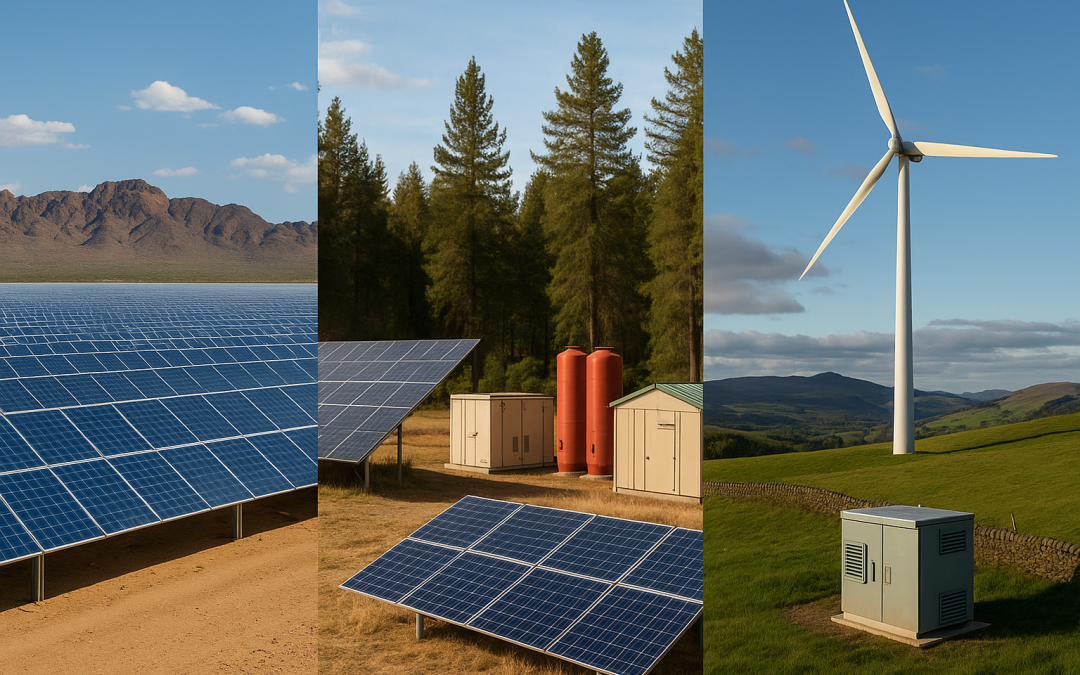Overview
Arizona’s Salt River Project (SRP) is preparing to meet surging demand driven by population and commercial growth. California’s tribal microgrids are setting new standards in long-duration storage and community resilience. Scotland’s 2025 Power Generation and Consumption Act is laying the groundwork for a nation-wide certified microgrid program. Stakeholders in all three regions are experimenting with AI-enabled controls, hybrid storage systems, and streamlined regulatory models. Below, we outline the key developments in each region and suggest how an experienced energy-consulting partner might help accelerate these efforts.
1. Arizona & SRP’s Expansion Trajectory
1.1 Rapid Load Growth and Renewable Targets
SRP forecasts residential load rising almost 8 percent from FY 2025 to FY 2030, driven by new housing starts, rooftop solar installations, and increased cooling needs during hotter summers.
Over the same period, commercial and large-industrial load is expected to grow more than 50 percent, fueled by data-center construction, manufacturing expansions, and EV-charging infrastructure deployments.
To address that surge, SRP’s board approved adding roughly 7,000 MW of new renewable resources by 2035, including at least 6,000 MW of large-scale solar, with goals of reducing CO₂ emissions and buffering customers from fuel-price volatility.
By the mid-2020s, SRP plans to commission over 2 GW of utility-scale solar and 1 GW of battery storage to create the flexibility needed for peak-demand management and to handle solar intermittency.
Concurrently, SRP will retire over 1,300 MW of coal generation by 2032 to align with its 2035 Sustainability Goals, which aim to cut CO₂ output in half from 2020 levels.
Financing includes a 2.4 percent net rate increase effective November 2025, supplemented by targeted debt issuance. This structure is designed to spread costs equitably while preserving SRP’s financial strength.
1.2 Challenges and Creative Responses
Grid flexibility and resiliency become critical as several gigawatts of solar and storage come online. Demonstration projects in the Southwest have shown that AI-driven controls can rebalance battery dispatch and shed non-critical loads in real time, reducing outage recovery times by up to 30 percent.
Interconnection bottlenecks arise when SRP seeks new capacity. The 2025 All-Source RFP for 600 MW by 2031 highlights the need to standardize technical requirements, expedite substation upgrades, and streamline engineering reviews actions that can reduce soft costs and shave months from project timelines.
Critical-load resilience is a priority for hospitals, data centers, and water plants. Hybrid microgrids that combine solar arrays, utility-scale batteries, and backup generators have shown multi-day islanded operation in other regions, ensuring uninterrupted service for essential facilities.
1.3 Ideas for Accelerating Arizona’s Evolution
AI-enhanced controls can be piloted to forecast weather and load patterns, enabling microgrids to anticipate changes in solar output and recharge batteries proactively.
Streamlined engineering templates and joint workshops between SRP staff and developers could standardize interconnection studies, reducing back-and-forth and lowering soft costs.
Blueprints for resilient microgrids at hospitals and data centers complete with preliminary one-line diagrams, protection schemes, and return-on-investment estimates could be made “shovel-ready” for federal and state incentives.
2. California’s Tribal Microgrid Renaissance
2.1 Paskenta Band and Zinc-Battery Innovations
The Paskenta Band microgrid in northern California will combine 3.5 MW of solar, 15 MWh of zinc-based battery storage, a 1 MW fuel cell, and 6 MW of diesel generators under an advanced microgrid controller, ensuring continuous power for a tribal hospital and community center.
Funded in part by a $32 million grant from the California Energy Commission (CEC), this deployment is one of the largest non-lithium storage projects in North America. It exemplifies how state grants can bolster energy sovereignty and resilience for rural communities.
Earlier CEC rounds supported the Barona Band’s 1.5 MW/6.6 MWh zinc-bromine microgrid and Blue Lake Rancheria’s solar-plus-950 kWh lithium-ion battery system. These projects demonstrate that non-lithium chemistries can reliably support critical loads for 24 hours or more.
2.2 Resilience and Equity Benefits
Tribal microgrids ensure health clinics, emergency shelters, and water treatment facilities remain operational during wildfire-related outages and extreme heat events.
Reliable power enables tribal enterprises casinos, resorts, and small businesses to operate continuously, fostering economic development and preserving cultural events without fear of blackouts.
The CEC’s emphasis on non-lithium, long-duration storage has positioned Northern California as a national proving ground for storage solutions beyond conventional lithium-ion.
2.3 Ideas for Enriching California’s Tribal Pathway
Expanded feasibility studies could incorporate cultural priorities, determining how site layouts, operator training, and local job creation align with tribal values.
Incorporating predictive analytics into operations and maintenance can extend the life of zinc batteries by detecting subtle performance changes before they lead to failures.
Blending CEC grants with federal microgrid controller tax credits and local resilience bonds could reduce tribes’ upfront capital burdens and ensure long-term affordability.
3. Scotland’s Certified Microgrid Framework
3.1 The 2025 Power Generation and Consumption Act
Effective May 2, 2025, Scotland’s Power Generation and Consumption Act establishes a certified microgrid program, creating uniform technical standards and a single-window application process for on-site power at hospitals, water utilities, and other critical facilities.
By standardizing requirements, Scotland has reduced permitting timelines from years to months, enabling facilities to deploy resilient microgrids more quickly while lowering soft costs such as legal and consulting fees.
3.2 Beyond Certification: Hydrogen and Storage Pilots
HydroGlen, a green-hydrogen microgrid in the Highlands, combines on-site wind and solar with electrolyzers, hydrogen storage, and fuel cells to ensure continuous power during the two-week winter darkness.
Scotland’s Clean Power 2030 Action Plan calls for 95 percent of electricity to come from clean sources by 2030, driving an anticipated build-out of 12 GW of onshore wind and 8–11 GW of offshore wind. These developments will require flexible microgrids and storage to maintain system stability.
3.3 Ideas for Adapting Scotland’s Model in the U.S.
Developing uniform interconnection checklists including voltage levels, metering standards, and protection settings could expedite microgrid permitting in U.S. jurisdictions.
Creating a “clean-energy bond” program backed by state and local governments could bundle public and private capital, lowering borrowing costs and attracting institutional investment for multiple microgrid projects.
Collaborating with technical colleges to develop microgrid operator certification programs can build the skilled workforce needed for operation and maintenance, replicating Scotland’s approach to renewable workforce training.
Conclusion
Arizona, California, and Scotland each illustrate unique aspects of the clean-energy transition. SRP’s rapid load growth necessitates flexible resources and grid upgrades. California’s tribal communities are demonstrating equity-driven, non-lithium storage strategies. Scotland’s certified microgrid framework is streamlining regulatory pathways and enabling green-hydrogen integration. Common threads include the importance of AI-enabled controls, hybrid storage solutions, and standardized frameworks to unlock financing. By learning from one another and applying these lessons, stakeholders can create replicable models that deliver reliable, affordable, and resilient power from Phoenix to Perth and beyond.
Sources
- SRP Proposed Adjustments to Standard Price Plans (January 2025), SRP
- SRP Board Approves System Plan Strategies (April 2024), SRP Media Release
- “SRP Seeks 2.5 GW Clean Power, 1.2 GW Peak Capacity” (March 2024), Utility Dive
- “Eos Contributing 15 MWh Zinc Storage to Faraday Microgrid” (May 29, 2025), Microgrid Knowledge
- “Eos and Faraday Partner on California Tribal Microgrid” (May 30, 2025), Energy Storage News
- Paskenta Band Microgrid Details (California CEC Tribal Microgrid Program)
- “Scotland’s Power Generation and Consumption Act Creates Certified Microgrid Program” (May 2025), Microgrid Knowledge
- “Green Hydrogen Microgrid Could Transform Rural Energy in Scotland” (December 2024), Microgrid Knowledge
- “Training Provision in Scotland’s Onshore Wind and Solar Industries” (January 2025), ClimateXChange
- SRP 2025 All-Source RFP (600 MW by 2031), SRP Public Document
- “AI Forecasting Secures Critical Loads” (April 2025), Utility Dive


Recent Comments